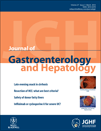Effect of melatonin and misoprostol on bacterial translocation in portal hypertensive rats
Abstract
Background and Aim: Portal hypertension is the main complication of cirrhosis and it is responsible for its most common complications. Bacterial translocation increases the morbidity and mortality rates in patients with portal hypertension. We aimed to investigate the effects of melatonin and misoprostol on bacterial translocation induced by portal hypertension.
Methods: We established four groups, each containing eight rats. Except for the control and sham groups, the animals in the other groups (treatment groups) received misoprostol or melatonin for 3 days after the first operation. In the sham group, a laparotomy was carried out and only the portal vein was dissected. Calibrated portal vein ligation was carried out in the other groups. All animals were given 1010Escherichia coli by orogastric intubation 12 h before sampling. Seventy-two hours after the first operation, mesenteric lymph node and blood samples were obtained and cultured. Two cc blood samples were obtained for a polymerase chain reaction study. A piece of terminal ileum was also sampled for histopathologic examination.
Results: Mesenteric lymph node and blood cultures of all control animals were positive for microbiological growth, and polymerase chain reaction results were positive in seven of the eight rats. Histopathologically, edema, vasodilatation and inflammatory cell infiltration were found to be less in the other groups in comparison to the control group. The incidence of bacterial translocation was decreased in all treatment groups as compared to the control group.
Conclusions: In this study, bacterial translocation occurred in portal hypertension. Melatonin and misoprostol reduced the incidence of bacterial translocation in portal hypertensive rats.




